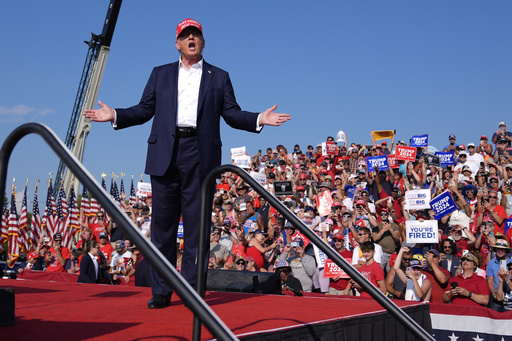WASHINGTON (AP) — A U.S. Secret Service sniper killed the would-be assassin of former President Donald Trump in a split-second decision, taking out the man perched on an adjacent rooftop.
Secret Service Director Kimberly Cheatle has publicly praised the sniper’s quick work on Saturday. But the Counter Sniper Team is now subject to a review by the Office of the Inspector General, which aims to determine how well the team is “prepared to respond to threats at events.”
The Secret Service was already subject to a more general probe from the Inspector General as well as congressional subpoenas regarding the shooting at the Trump campaign rally, in what has become the most intense scrutiny the agency has faced since President Ronald Reagan was shot in 1981.
Here’s what to know about the agency’s elite sniper group.
Sniper team is ‘very elite and difficult to get into’
The Counter Sniper Team was established in 1971. It provides intelligence and observations of potential threats from far away in an effort to protect U.S. presidents, vice presidents, first ladies and others, according to a 2020 report by the Government Accountability Office on federal tactical teams.
Those who join the team have already worked for the Secret Service for at least two years, according to the agency’s website. They must undergo 11 weeks of counter sniper selection and basic training, along with a color vision test. Counter snipers must have excellent eyesight and hearing.
“It’s very sought after, it’s very elite and difficult to get into,” Pete Piraino, who spent 23 years with the Secret Service, including five years in the presidential protective division, told The Associated Press on Thursday.
They typically work in pairs
The counter snipers are on the look out for threats from far away, even beyond the established security perimeter, said Piraino, who is now vice provost for academics and a criminal justice professor at Tiffin University in Ohio. They often work outdoors, focusing on rooftops and the windows of surrounding buildings.
They typically work in teams of two — one serves as a spotter while the other trains their rifle’s sight on the same area.
“They’re trained to scan an area, remember what they see and come back to scan it again and see if there’s any change,” Piraino said. “It’s not just a matter of picking up their binoculars and looking around. They are trained very thoroughly and specifically with rangefinders and their equipment.”
If they don’t qualify, they don’t work
The counter snipers, code named “Hercules,” can respond to a threat from a distance with their .300 Winchester Magnum rifles, according to Ronald Kessler’s 2009 book, “In the President’s Secret Service.” And they have to prove they can do so on a monthly basis.
“Counter-Snipers are required to qualify shooting out to a thousand yards each month,” Kessler wrote. “If they don’t qualify, they don’t travel or work.”
The snipers shoot with a rifle called a JAR, said Paul Eckloff, a retired Secret Service agent who served on details protecting three different presidents during his 23-year career.
“You’ve never heard of it because the Secret Service makes them,” Eckloff said.
It stands for “just another rifle” and they’re built specifically for each counter sniper by the Secret Service’s armorer to take into account things like the length of the shooter’s arms, wrists and trigger finger.
Eckloff wouldn’t disclose how many counter sniper teams there are but noted that it’s a finite resource and they could always use more.
What happened?
Police learned of a suspicious character outside the fairgrounds in Butler, Pennsylvania, before Trump took the stage. Minutes into his speech, shots were fired.
A counter sniper shot and killed Thomas Matthew Crooks in the seconds after he opened fire from a rooftop some 150 yards (135 meters) from the stage. Secret Service agents threw themselves on top of the former president before hustling him off stage.
Stephen Colo, who retired from the Secret Service in 2003 as an assistant director, told The AP on Sunday that presidential candidates and former presidents don’t typically get the same level of protection as the sitting president.
Colo said he was surprised that the agency had staffed the event with a counter sniper team because there are not many of those highly trained operatives and they are usually reserved for the president.
Kessler told the AP that the Counter Sniper Team should not be the focus of all of the scrutiny and investigations. He said the Secret Service members working closer to Trump should have called off the speech and moved him to safety as soon as they heard reports of a suspicious person in the crowd and then on a nearby rooftop.
“They should have just evacuated as soon as there was any hint of danger,” Kessler said.
Trump was not seriously injured and two days later he arrived in Milwaukee, with his right ear bandaged, to the adulation of his supporters at the Republican National Convention.
The shooting had more serious ramifications for others at the rally. Former fire chief Corey Comperatore was shot and killed and two other people were wounded.
Cheatle, the Secret Service director, told ABC News on Tuesday that the sniper who shot Crooks made a “split-second decision.”
“They have the ability to make that decision on their own. If they see that it’s a threat and they did that in that instance,” she said.
“And I applaud the fact that they made that decision and didn’t have to check with anybody and thankfully neutralized the threat.”
___
Finley reported from Norfolk, Virginia.
Source: post





